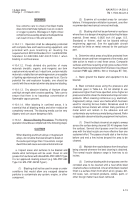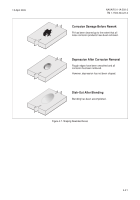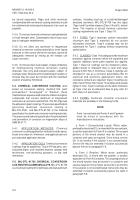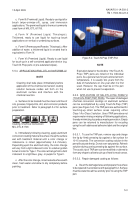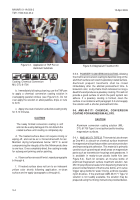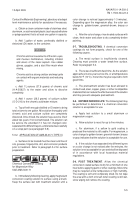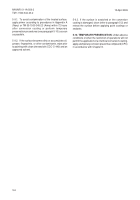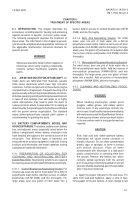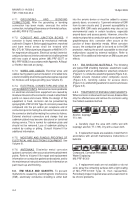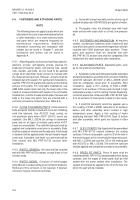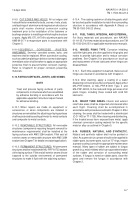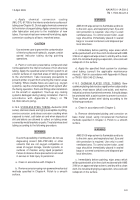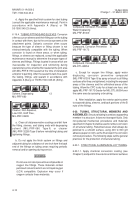TM-1-1500-344-23-2 - Page 105 of 240
6-1
NAVAIR 01-1A-509-2
TM 1-1500-344-23-2
15 April 2009
CHAPTER 6
TREATMENT OF SPECIFIC AREAS
6-1. INTRODUCTION.
This chapter describes the
procedures recommended for treating and protecting
against corrosion in specific, corrosion prone areas.
The following paragraphs describe the treatment of
these areas. The information in this chapter is general,
and should be amplified and expanded by reference to
the applicable maintenance instruction manuals for
specific aircraft.
WARNING
Observe precautions listed in other chapters or
references when using cleaning compounds,
solvents, surface treatments, sealants, and
paints.
6-2.
AIR INTAKE DUCTS FOR JET AIRCRAFT
. Air
intake ducts are fabricated from materials (usually
5000 series aluminum) which have high corrosion
resistance. Certain components of these ducts may be
cast aluminum or magnesium. Frequent cleaning of the
ducts is usually sufficient to preclude attack by corrosion.
Activities operating aircraft performing low level missions
or take-off and landings over salt water or in highly
saline atmospheres may need to paint the ducts to
reduce corrosion attack. A requirement for a coating as
determined by the operating activity shall be coordinated
with the parent service organization. The standard
epoxy primer/polyurethane topcoat paint system is
recommended for painting the ducts.
6-3. BATTERY COMPARTMENTS, BOXES, AND
ADJACENT AREAS.
The battery, battery cover, battery
box, and adjacent areas (especially areas below the
battery compartment where battery electrolyte may
have seeped) are subject to the corrosive action of the
electrolyte. Two different types of batteries are
encountered on aviation equipment: lead acid, having
a sulfuric acid electrolyte; and nickel-cadmium, having
a potassium hydroxide electrolyte.
6-3.1. PREPARATION OF SOLUTIONS FOR
CLEANING AND NEUTRALIZING BATTERY
ELECTROLYTES. Neutralizing solutions are required
for cleaning areas contaminated with battery electrolyte.
6-3.1.1. Sodium Bicarbonate Neutralizing Solution. For
small areas, pour one pint of fresh water into a 500 ml
polyethylene wash bottle. Add two ounces of sodium
bicarbonate (ASTM D928) and mix thoroughly. For
large areas, pour one gallon of fresh water into a
bucket. Add six ounces of sodium bicarbonate (ASTM
D928) and mix thoroughly.
6-3.1.2. Boric Acid Neutralizing Solution. For small
areas, pour one pint of fresh water into a 500 ml
polyethylene wash bottle. Add one-half ounce of boric
acid powder (A-A-59282) and mix thoroughly. For large
areas, pour one gallon of fresh water into a bucket. Add
four ounces of boric acid powder (A-A-59282) and mix
thoroughly.
6-3.1.3. Monosodium Phosphate Neutralizing Solution.
For small areas, pour one pint of fresh water into a
500 ml polyethylene wash bottle. Add two ounces of
monosodium phosphate (AWWA B504) and mix
thoroughly. For large areas, pour one gallon of fresh
water into a bucket. Add six ounces of monosodium
phosphate (AWWA B504) and mix thoroughly.
6-3.2. CLEANING AND NEUTRALIZING PROCE-
DURES.
WARNING
When handling electrolytes, splash proof
goggles, rubber gloves, and rubber aprons
shall be worn. If any electrolyte contacts the
skin or eyes, flood the affected area immediately
with water and consult the Base Medical Service.
An emergency shower and an eye wash station
in the area where work is being performed are
required.
CAUTION
Both lead acid and nickel-cadmium battery
electrolytes will cause severe corrosion of
metallic structure. Do not allow contaminated
gloves, rags, or sponges, to come in contact
with aircraft structure. Place all items
contaminated with electrolyte in a leak-proof
plastic container prior to removing them from
the aircraft. Remove any battery box which
contains spilled electrolyte from the aircraft
prior to cleaning it. Electrolyte spilled on aircraft
structure shall be cleaned up as soon as possible
after it has been detected.
a. Apply the proper indicator to the spill area. For
spills from lead-acid batteries, apply a strip of blue
litmus paper to the wet surface. A color change to red
Back to Top

